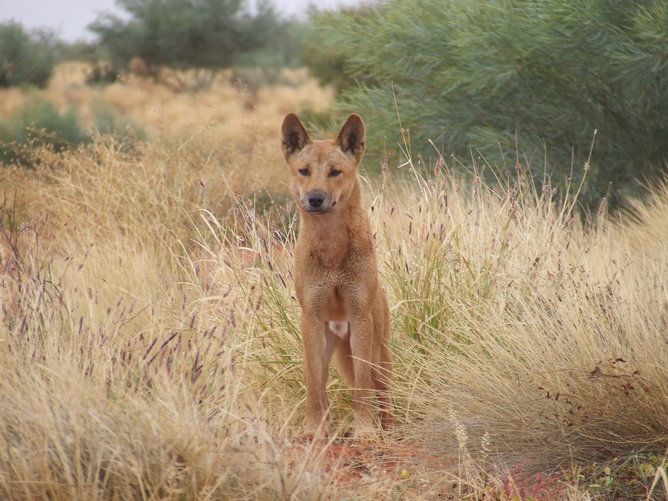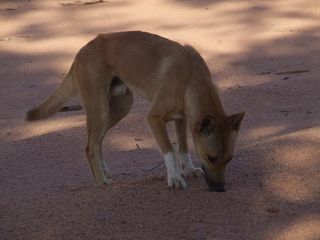
Australia Should Enlist Dingoes to Control Invasive Species (Op-Ed)

This article was originally published at The Conversation. The publication contributed the article to Live Science's Expert Voices: Op-Ed & Insights.
Introduced species pose one of the greatest threats to Australia’s fauna and flora, but expensive efforts to control them aren’t working. Instead of spending millions of dollars on culling, giving dingoes a hand could help Australia’s wildlife. Evidence shows dingoes control invasive species free of charge.
Recently, some of Australia’s conservation biologists have called on the government to invest the nation’s limited conservation funds on a more limited number of threatened species (conservation triage).
Even the best-funded National Parks are failing to preserve threatened species, and declines and extinctions are occurring both in and out of protected areas. Despite the resources expended we have made little headway in the conservation of endangered species. More money won’t necessarily help.
Cost of culling
In Australia, introduced predators and herbivores are a leading driver of biodiversity loss. Killing introduced species therefore makes up a substantial portion of the conservation budget, with an estimated spending of at least A$10-20 million annually to control the six Most Wanted offenders (foxes, dingoes, cats, rabbits, pigs and goats).
According to 2006 data Parks Victoria spends approximately A$5 million annually, or 4 percent of their annual budget, controlling introduced mammals, and invests an extra A$2 million annually on research into improving pest control methods.
Last year the Commonwealth Cooperative Research Centre Program spent A$3.9 million on the Invasive Animals CRC “to counteract the impact of invasive animals” on agriculture and biodiversity.
Sign up for the Live Science daily newsletter now
Get the world’s most fascinating discoveries delivered straight to your inbox.
Many ways to kill
In the name of conservation animals are shot, trapped, poisoned, infected with disease and sterilised and their lairs are destroyed with heavy machinery, fumigation and explosives. Introduced plants are manually ripped, bulldozed, poisoned and burned. These extreme measures are justified by perceptions that introduced species threaten native species, and that pest control can help alleviate this threat.
This approach has however failed on all fronts: it generally does not produce a sustained decline in the target “pest” species nor does it help “native” species.
Frequently it actually makes matters worse. When rabbits were culled on Macquarie Island, the resident cats turned to seabirds. And when the cats were removed, the rabbits destroyed the native vegetation. Very few pest control operations have even yielded knowledge on their efficacy.

Free control
The majority of threatened species recovery plans call for lethal control of introduced species, particularly predators. The poison 1080 is very effective at killing carnivores and sits at the front of the standard conservation first aid kit.
But instead of limiting the populations of foxes and cats, it often makes things worse. Dingoes, which otherwise control introduced predators, also eat the bait. With no other predators, foxes and cats increase.
Where poison-baiting is applied, many native mammals often decline due to higher predation pressure by foxes and cats. Wild herbivores, such as kangaroos and rabbits, also increase to unsustainable numbers and damage vegetation. Unlike controversial culling programs dingoes offer both an efficient and compassionate method of population control.
Although the dingo is one of the strongest examples known of the ecological role of an apex predator, there are currently no safe places for dingoes.
Unfriendly place for dingoes
Large carnivores are some of the most imperilled species on the planet. Usually, the debate rages between pastoralists — who wish to protect their livestock — and conservationists — who wish to protect predators.
In Australia, the situation is more complicated because dingoes have been caught up in an ongoing war on introduced species. National Parks are particularly dangerous places for dingoes, where the intensity of predator-control makes many pastoral lands seem like predator-friendly havens.
The common practice of shutting down “artificial” water points in conservation lands further excludes dingoes from large tracks of the arid zone. It is now clear that the very methods used to help recover threatened species have instead been major drivers of their decline.
We need a fresh start
We will probably never know how Australia’s ecological history would have played out had dingoes remained unharmed and introduced species naturally controlled. Although some species would have succeeded in establishing in Australia, they would not have had the dire impacts on local fauna and flora we have come to associate with introduced species.
Looking to the future, the conservation of dingoes offers a way forward for biodiversity conservation that is cost-effective, sustainable and ethical. Instead of spending money on fewer endangered species, we could broaden our view to the ecological mechanisms that enable species to adapt to change.
The Australian ecology may be significantly more resilient than we believe, and capable of successfully containing a mixture of the native and the introduced, if dingoes are allowed to recover. This will require major shifts in the way we see big predators, what we consider to be our role in promoting biodiversity, and an acceptance of introduced species as the permanent residents that they are and will continue to be.
Arian Wallach does not work for, consult to, own shares in or receive funding from any company or organisation that would benefit from this article, and has no relevant affiliations.
This article was originally published on The Conversation. Read the original article. The views expressed are those of the author and do not necessarily reflect the views of the publisher. This version of the article was originally published on Live Science.












